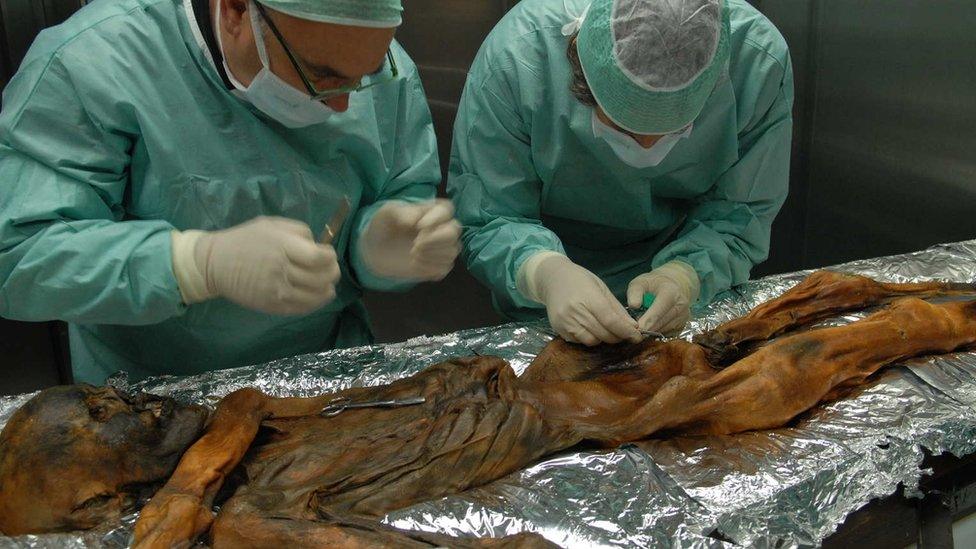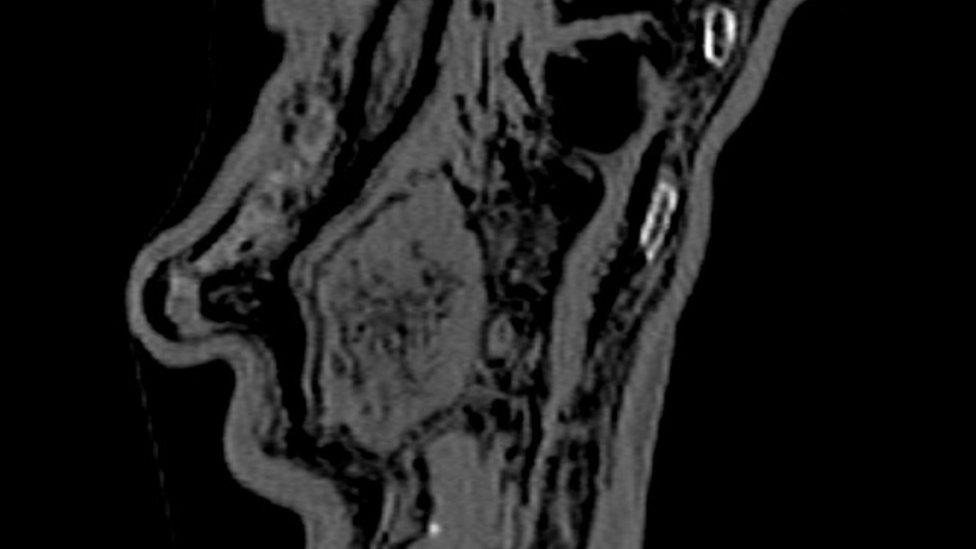Oetzi the Iceman had a stomach bug, researchers say
- Published

Oetzi the Iceman had Helicobacter pylori bacteria in his stomach before he died
Microbes extracted from the insides of a 5,300-year-old mummy have shown he was suffering from a stomach bug before he died, scientists have discovered.
Oetzi the Iceman, the name given to the frozen body discovered in the Alps in 1991, had a bacterial infection that is common today, researchers said.
He had been killed 5,300 years earlier after being struck by an arrow.
The research is published in the journal Science, external.
This new study suggests he was suffering from an infection that can cause stomach ulcers and gastritis.
A genetic analysis of the bacteria was carried out, helping to trace the history of the microbe, which is closely linked to the history of human migration.

The researchers had to defrost the 5,300 year old mummy to extract the microbes
The frozen corpse of Oetzi has allowed scientists to look back at his life in unprecedented detail.
Previous research has revealed that he was between 40 and 50 years old, had brown eyes, was covered in tattoos and had recently eaten ibex.
He was found with an arrow in his left shoulder, and most likely died of blood loss. However he also suffered other medical problems, including heel fractures, arthritis and possibly Lyme disease.
Now, to add to his health woes, scientists have now discovered the Helicobacter pylori bacteria.
Prof Albert Zink, head of the Institute for Mummies and the Iceman, at the European Academy in Bolzano (EURAC), said: "One of the first challenges was to obtain samples from the stomach without doing any damage to the mummy.
"Therefore we had to completely defrost the mummy, and we finally could get access by an opening - by an incision that was already done by a previous study.
"We were able to obtain samples from the stomach content, from some of the intestinal content, and also from the parts of the stomach wall."

The microbes were extracted from Oetzi's intestines and stomach wall, shown here in an x-ray
The bacteria are found in about half of the population today, and in about 10% of cases can lead to inflammation of the stomach lining and ulcers.
The researchers do not know what clinical symptoms Oetzi displayed, but there was evidence that the bacteria reacted with the Iceman's immune system.
Sequencing the genome of the microbe has also provided new information about ancient human migration.
The strain that infects Europeans today is thought to be the result of two older strains - one African and one Asian - combining.
Essentially this means infected people from these two areas must have come together and mixed.
However, the microbe found in Oetzi was different.
"We had assumed that we would find the same strain of Helicobacter in Oetzi as is found in Europeans today," said Thomas Rattei, from the University of Vienna, in Austria, who worked on the study.
"It turned out to be a strain that is mainly observed in Central and South Asia today."
This suggests that there may have been a wave of people from Africa, who were carrying the bacteria, into Europe at some point after Oetzi's death.
"The recombination of the two types of Helicobacter may have only occurred at some point after Oetzi's era, and this shows that the history of settlements in Europe is much more complex than previously assumed," says Frank Maixner, from Eurac.
It adds to the growing evidence that rather than a single movement of humans out of Africa and into Europe, there were several migrations.
Follow Rebecca on Twitter, external
- Published10 October 2013

- Published2 May 2012

- Published28 February 2012
- Published28 February 2011